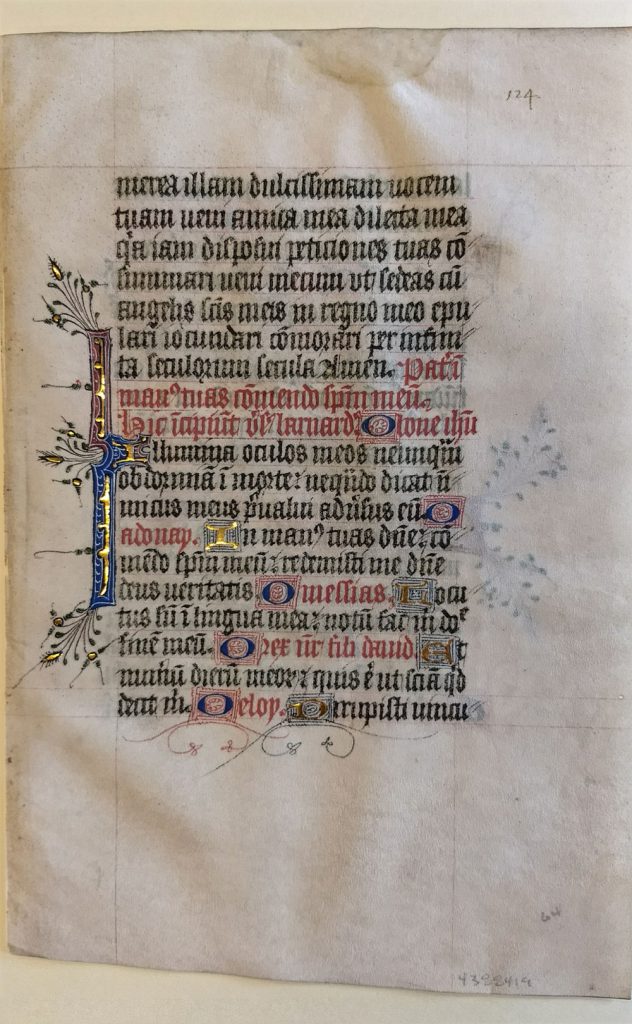
We’re doing something a little different in this year’s Hargrett Hours class: we’re undertaking a service project for the Special Collections Libraries. One of UGA’s great pedagogical assets is their Office of Service Learning, which helps instructors across the disciplines integrate service projects into their curriculum. For example, I’ve had one colleague in my department design compelling multicultural lit classes that included, as their service component, tutoring in the Latin@ community; another runs a series of service courses designing web sites and other promotional materials for rural Georgia counties. How wonderful is that?
It’s a little more challenging to design a service-learning course around medieval material. Not a lot of communities need their quills sharpened or iron gall ink mixed. So I was excited when Anne Meyers Devine of the Hargrett Library saw the same need I did: a need to improve the discoverability of our medieval and early printed materials. It’s surprisingly difficult to do a library search and find all our medieval materials, and there are issues with some catalogue entries that, for institutional reasons, can’t be addressed. In short, people can’t easily figure out what medieval items we own.
Let me tell you a story about why this is a problem. A few years ago, Lisa Fagin Davis, President of the Medieval Academy and a major wheel in the world of US manuscripts, started out on a (primarily virtual) Manuscript Road Trip blog adventure through the US, looking at the holdings of institutions in every state. When she came to Georgia in 2014, Lisa (bless her heart) hit the different universities in the Atlanta area but didn’t make the side trip to Athens. So she missed out on our beautiful Spanish gradual, our fragments (Lisa loves fragments), and the Hargrett Hours. Of course, that’s because our manuscripts and fragments have no digital footprint: they’ve not been digitized or even fully described online. There was no way for a researcher to know that the Gradual is provenanceable, that the Hargrett Hours has a Sainte-Chapelle calendar, or (unless they get lucky in the catalogue) that we now own four leaves from the Cotterell-Throckmorton Hours.

Fast forward to September 2015, when Lisa and her collaborator, Melissa Conway, published their “Directory of Collections in the US and Canada with Pre-1600 Manuscript Holdings,” an update of the authoritative handlist of manuscripts held by North American institutions. Here’s a screencap of the entry for UGA:

Actually, before 2015 we had four codices and three folders of fragments (14-15 by my count).
Granted, the “Directory” does make clear that it only provides “general information on pre-1600 manuscript holdings.” Still, how were Lisa and Melissa to have good information on our manuscript holdings when they’re not fully described?
This is a problem from Anne’s perspective, as a librarian, as well as mine, as the local medievalist. No library wants to disseminate partial or incorrect information about their holdings, but many libraries don’t have the staff to properly catalogue and describe the materials on the outer reaches of their collecting areas. And while the Special Collections Libraries have been generous in acquiring new materials for me to teach with, “medieval” is not really what they do. Moreover, even when staff have the knowledge and desire to improve their collections’ discoverability – as Anne certainly has for our early printed books – they don’t always have the time. The Special Collections Library is boss at doing outreach, whether it’s teaching classes for UGA faculty, bringing in students from the public school district, or planning community events. But all that takes energy.
That’s where our service-learning class comes in. While individual students won’t have the knowledge level to describe our medieval materials properly, teams of students can, especially when they’re operating under the oversight of experts like Anne. So in this series of service-learning classes, our students will be working closely with the librarians to better describe and publicize the early materials that UGA owns.
This semester, we’re conceptualizing the larger project: our students will be designing a home page for the Hargrett’s medieval and early printed materials, a hub of sorts where fuller descriptions of these materials can be made available. Working with Anne and the other librarians to figure out the best kind of page(s) to meet the library’s needs, we’ll figure out ways to improve the discoverability of our medieval and early printed books. Future classes will then build out from this design, doing the actual descriptions and perhaps digitizations of (at least) the fragments. We’ll see – it’ll depend on what the librarians want.
Our medieval holdings at UGA may not be as extensive as those at Yale or Penn, or growing as fast as those at the University of South Carolina, but we do have some exciting pieces that deserve attention – yes by our own undergraduates, but also by scholars more broadly.